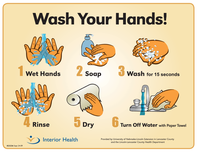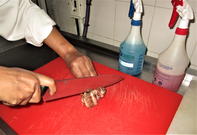Why has South Africa suffered a serious outbreak of listeria in 2017/2018? Listeria monocytogenes - although it sounds mysterious and threatening - is an ordinary bacterium that is frequently carried in the animal or human intestine without causing any symptoms.

But it has emerged as a killer causing over 1000 cases of human illness and more than 200 deaths, with very young babies, adults over 70 years and immune deficient individuals as the most affected groups. The listeria organism is present in our surroundings and easy to find.
The listeria organism is carried by (especially) cattle, sheep and goats rather than pigs and dogs and humans and is more common in cold-climate countries. Incidentally, the ST6 strain which has been identified as responsible in the 2017/2018 outbreak has never been isolated from pigs in South Africa.
So, the cold meats were almost certainly contaminated by human hands and packaging, not from the meat.
How to Prevent Listeria

Listeria monocytogenes can easily be killed by cooking and is treatable with disinfectants and antibiotics. If this organism has been relatively harmless for many years around the world, why did it suddenly produce the worst outbreak of listeriosis on record? It was an unfortunate combination of factors that help to ensure its survival and growth.
These include: The ST6 was a particularly aggressive strain (probably due a minor mutation) causing various symptoms ranging from mild flu to fatal inflammation of the brain.
It is able to survive and grow at cold temperatures such as those in household refrigerators and commercial cold rooms and does not produce any notable colour or odour changes in the product. It persists in the biofilms (the thin organic coating that can build up on working surfaces and floors) and injured individual cells the bacteria can repair themselves when conditions become favourable.
The disease has a very variable and often long incubation period (70 days) before symptoms become evident and the infected person or animal may not show obvious diagnostic signs at first. Diagnosis and backtracking to identify the source of infection are therefore difficult and time-consuming.
All of this allows listeria to gain entry into abattoirs and meat processing plants and household kitchens. If cleaning and disinfection are not absolutely thorough, the surviving bacteria will multiply in refrigerated, and warm areas and biofilms, then pass the contamination right down the distribution chain from the processing factory to consumers' kitchens.
Tips for Food Hygiene

There are some essential rules to prevent diseases spreading during the handling of food. Everyone working with raw meat must wash their hands frequently. All kitchen tools and working surfaces must be cleaned repeatedly: before, during and after handling food.
Clean light-coloured aprons are recommended for all food handlers. Cutting boards must be made of a smooth material. Avoid wood, it is too difficult to disinfect. Never use the same cutting board, kitchen tools or containers for raw and cooked foods without cleaning and disinfecting after every use.
Use a food-safe kitchen detergent, cleaning and disinfecting agent in your kitchen. Remember that cleaning is 90% - the most important aspect - of effective decontamination. Wet wiping rags (‘lappies’) are absolutely the worst. They are the biggest offenders for spreading bacteria. Rather use hot water and disposable dry paper towels for rinsing and drying kitchen tools.
Keep the kitchen as clean as a hospital. The floors, walls, tables, storage bins, refrigerators and especially door handles need continuous cleaning.
By Dr Jim Robinson